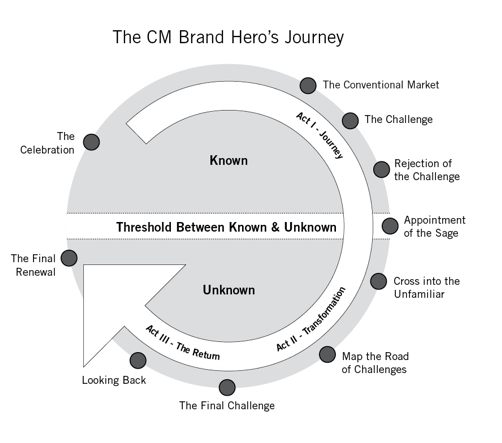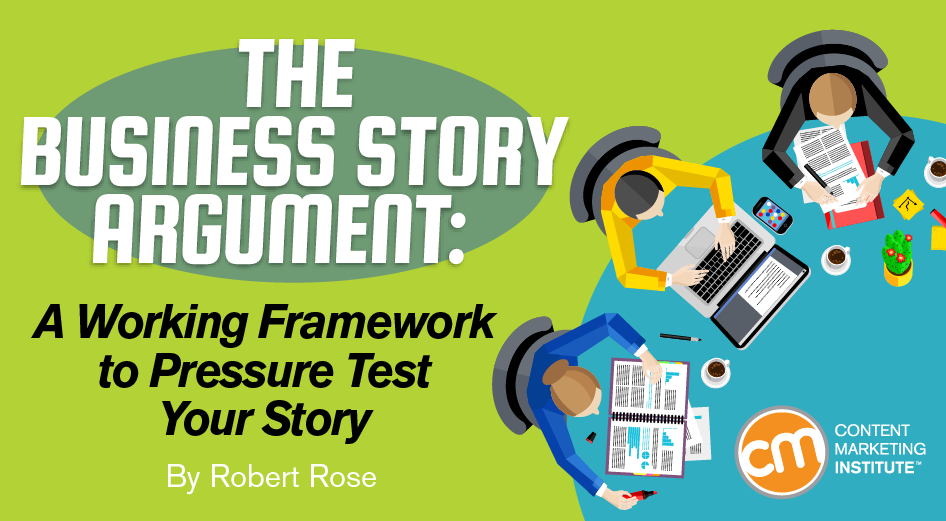Its usefulness is in how it can help you pressure test an idea for a story you already have. But if you can pressure test your ideas more quickly, perhaps you can at least improve the chances of focusing only on the best ideas or provide clearer direction for your existing content marketing initiative. However an idea comes into your possession, know that every great story has four distinct parts: The human – Every great story has a human soul at its core, even if that human is a talking Lego character. In every great story, the audience can see themselves in the hero. Resistance = outcome for the audience – As content marketers, you help deliver challenges and adventures for the audience to go through. When you’ve created a great story, you should be able to provide satisfying answers to these questions: Who is your human hero? Have you truly tested your hero? The answers to these questions can be combined to get to your content mission or to pressure test the story you have in mind. Act 3: The framework in action Once you have identified answers to the seven components, you can combine them into the four parts of the great story to get to the anatomy of your content mission. You can use the four parts of your great story as the anatomy of a wonderful and differentiated argument, the heart of a great business story.

Storytelling.
It’s got a bit of a buzz these days doesn’t it?
It seems every technology provider, agency, and consultant promises to help you tell a better story. But what does “telling a better story” even mean?
To tell a better story, do marketers need to be edgier and differentiate themselves to an audience numb to everything except the completely outrageous? Maybe. But that ultimately seems like a zero-sum game. How many more over-the-top content ideas do you produce before you jump the proverbial shark? Is BuzzFeed, with all its cat-video and which-Game-of-Thrones-character-are-you-quiz “trending buzz,” a huge success? Or, is it failing to differentiate?
And, the way things are going lately, today’s mainstream news headlines are probably going to be more outrageous than your brand ever will anyway.
Does “telling a better story” mean you just need to put more and more detail into your content? Give away all the thinking and bombard your audience with so much quality and detailed facts that they must appreciate the sheer amount of content (#AllTheEducation)?
No.
Neither of these approaches is at the root of getting to a better story. As so many of my mentors in storytelling drilled into my head – the heart of a great story is an argument for the truth. And, the truth has little to do with the number of facts or what happens, no matter how outrageous. As one of my mentors – the great storytelling coach Robert McKee – has written, “What happens is fact, not truth. Truth is what we think about what happens.”
If the last 24 months of the daily news cycle haven’t illustrated this “truth” in spades, I’m not sure what will.
Put simply: A great story is a well-crafted, entertaining, engaging, and (ultimately) convincing argument. With a fulfilling story, if I’m successful as an author, I’ve taken you on a journey and you believe (or are at least open to believing) something different at the end of it.
This is something you as a marketer can test as you create your content.
Prologue: The Business Story Argument Framework
I’ve worked with hundreds of marketing professionals and storytellers over the last 10 years. I’ve employed and customized a number of borrowed “tools” to help them get to better stories. If you read my first book, Managing Content Marketing, written with my colleague Joe Pulizzi, you might remember how we used a modified version of Joseph Campbell’s Hero’s Journey to help structure what we called the Brand Hero’s Journey.

If you read my book with Carla Johnson, Experiences: The 7th Era of Marketing, you might remember we’ve used the classic “5 why’s” as a means of helping content marketers get to a deeper, more meaningful story.
While I still use both approaches in coaching and in the content creation process, I recently found another approach that helps marketers pressure test a story to see if it has all the components that make it a good one rather than just an outrageous situation or a collection of facts. With a huge hat tip to my friend and writers’ coach Jeff Lyons and his Anatomy of a Premise Line, I customized a framework that I call the Business Story Argument Framework.
Now, the key utility of this framework is to know that it doesn’t write your story nor serve as a template. Its usefulness is in how it can help you pressure test an idea for a story you already have.
Getting to a satisfying story can be truly difficult. Add to that the fact that marketers are often pressed for time, and it’s just near impossible to truly settle in and think about how to create a meaningful, engaging, and convincing story that illuminates some greater truth about the world.
But if you can pressure test your ideas more quickly, perhaps you can at least improve the chances of focusing only on the best ideas or provide clearer direction for your existing content marketing initiative. Are you ready for the adventure? OK, let’s do it.
Act 1: Every great story has 4 parts
We all know creative ideas come from random places. I love the quote from Nicholas Negroponte who asked, “Where do new ideas come from? The answer is simple: differences. Creativity comes from unlikely juxtapositions.”
You may come to an idea for a content marketing story from any number of places. The lightning of an idea may strike you in the shower or while you’re walking the dog. Or you might be inspired by an idea that comes out of your team’s latest brainstorming standup. Or you may inherit a story because your company just acquired a brand that has a digital magazine.
However an idea comes into your possession, know that every great story has four distinct parts:
- The human – Every great story has a human soul at its core, even if that human is a talking Lego character. Nobody wants to hear the story of industrial manufacturing. They want to hear the story of Jane, the enigmatic heroine who finds herself challenged with leading a new industrial manufacturer.
- The goal – A goal is a conscious or unconscious desire of the human. The desire to achieve a goal is what propels our human hero through the story journey. When the goal is conscious…

COMMENTS